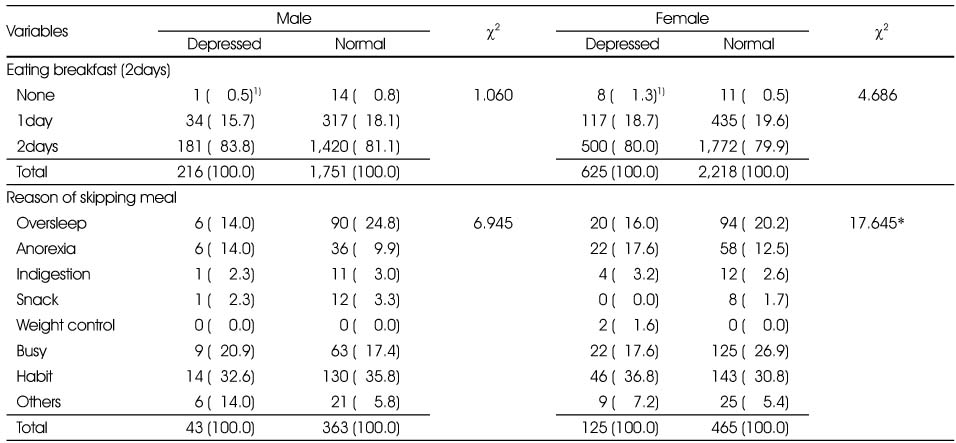References
1. Smith AP. Breakfast and mental health. Int J Food Sci Nutr 1998. 49(5)397–402.
2. An YM. A study on the comparison of nutrient intakes and the mental health of girl students between day and evening session of commercial high school and academic high school in Masan 1989. Kyung nam University; 37–38.
MS thesis.
3. Cheon SH. A study on eating behavior, depression, anger, anger expression and BAS/BIS in adolescent woman. Korean J Women Health Nurs 2007. 13(4)310–319.
4. Cho SS, Jung SH, Choi S, Sung NJ, Park KH. The relationship between depressive tendency somatic symptoms and drug use in housewives. J Korean Acad Fam Med 1997. 18(5)490–500.
5. Chung HK, Kim MH, Woo NRY. The effect of life stress on eating habit of university students in Chungcheongnam-do province. Korean J Food Cult 2007. 22(2)176–184.
6. Devaud C. Eating disorders among female adolescents in Switzerland : prevalence and associations with mental and behavioral disorders. Int J Eat Disord 1998. 24(2)207–216.
7. Dubow EF, Kauch DF, Blum MC, Reed J, Bush E. Correlates of suicidal ideation and attempts in a community sample of junior and high school students. J Clin Child Psychol 1989. 18(2)158–166.
8. Fava M, Rappe SM, West J, Herzog DB. Anger attacks in eating disorders. Psychiatry Res 1995. 56(3)205–212.
9. Han MH, Kim KJ. Consumption value and eating out behavior of male and female undergraduate students. Consumer Policy Educ Rev 2008. 4(3)105–118.
10. Hong SM, Choi SY. A study on meal management and nutrient intake of the elderly. J Korean Soc Food Sci Nutr 1996. 25(6)1055–1061.
11. Kang HC. Binge eating in obesity. J Korean Soc Study Obes 2000. 9(3)45–54.
12. Kim JH, Lee MJ, Moon SJ, Shin SC, Kim MK. Ecological analysis of food behavior and life : styles affecting the prevalence of depression in Korea. Korean J Nutr 1993. 25(9)1129–1137.
13. Kimmel PL, Weihs K, Peterson RA. Survival in hemodialysis patients: the role of depression. J Am Soc Nephrol 1993. 4(1)12–27.
14. Lee BY. Psychiatry dictionary 1997. Seoul: Ilchokak; 305.
15. Lee EY, Cho MS. Effects of mood on the food preference of female university students. Korean J Food Cult 2008. 23(6)713–719.
16. Lee SH, Suh JH. Korean public's ability to recognize depressive symptoms and beliefs on helpfulness of various methods. Ment Health Soc Work 2009. 41–77.
17. Linde K, Ramirez G, Mulrow CD, Pauls A, Weidenhammer W, Melchart D. St John's wort for depression-an overviewand meta-analysus of randomised clinical trials. BMJ 1996. 313253–258.
18. Ministry of Health and Welfare. Korea Health Industry Development Institute. Revision of Dietary Guidelines for Koreans 2008.
19. Ministry of Health and Welfare. Korea Centers for Disease Control and Prevention. 2008 Korean national health and nutrition examination survey (KNHANES) 2008.
20. Macht M, Mueller J. Immediate effects of chocolate on experimentally induced mood states. Appetite 2007. 49(3)667–674.
21. Park JE, Kim SJ, Choue RW. Study on stress, depression, binge eating, and food behavior of high school girls based on their BMI. Korean J Community Nutr 2009. 14(2)175–181.
22. Peveler R, Carson A, Rodin G. ABC of psychological medicine : Depression in medical patients. BMJ 2002. 325149–152.
23. Shaffer D, Pfeffer CR, Bernet W, Arnold V, Beitchman J, Benson RS, Bukstein O, Kinlan J, McClellan J, Rue D, Shaw J, Kroeger K. Practice parameter for the assessment and treatment of children and adolescents with suicidal behavior. J Am Acad Child Adolesc Psychiatry 2001. 40(7 Suppl)24S–51S.
24. Son SM, Park JK, Lee HS. Depression and dietary factors related to hyperlipidemia in urban living elderly female from low income group. Korean J Community Nutr 2003. 8(6)938–950.
25. Suh KY. The phenomenological study on the complaints of depression in Korea. Korea Univ Med J 1968. 5(1)491–501.
26. Sung SJ, Kwon SJ. Effect of eating with family or alone on the self-rated mental or physical health : the elementary school children in Daejeon area. Korean J Community Nutr 2010. 15(2)206–226.
27. Torres SJ, Mccabe M, Nowson CA. Depression, nutritional risk and eating behaviour in older caregives. J Nutr Health Aging 2010. 14(6)442–448.










